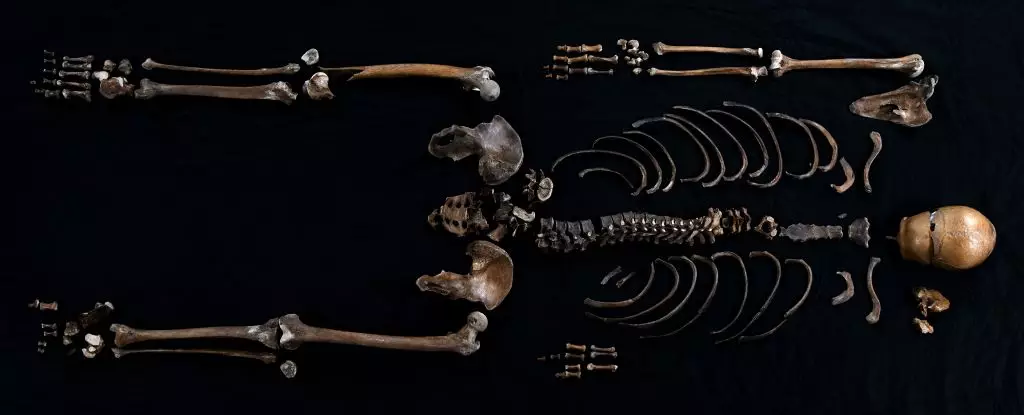The intersection of archaeology and historical texts often yields astonishing revelations and challenges long-cherished narratives. A recent scientific endeavor, centered on a figure known as the Well Man, highlights the intricate relationship between documented history and physical remains, revealing not only the identity of a long-deceased individual but also shedding light on the medieval conflict that marked Norway’s tumultuous past.
The Sverris Saga, a 13th-century chronicle detailing the reign of King Sverre Sigurdsson, mentions an intriguing incident: a corpse tossed into a well as a means of contaminating the water supply. This narrative, seemingly a mere footnote in the saga, gained new significance when scientists announced the identification of actual human remains found in 1938, at Sverresborg Castle, near Trondheim. For decades, these bones languished without proper examination due to insufficient technological means. However, today’s advancements in genomics and isotopic analysis have breathed new life into the inquiry.
The bones belonged to a male, estimated to be between 30 and 40 years old at the time of death. The complexity of the studies required a multifaceted approach, leveraging radiocarbon dating, genome sequencing, and isotope analysis, which together painted a more vivid picture of not only how he lived but potentially even who he was. This exploration by a team led by Martin Ellegaard from the Norwegian University of Science and Technology is groundbreaking; it represents the first organism from medieval texts that has found a tangible counterpart within the archaeological record, bridging the gap between literature and real-world evidence.
Radiocarbon dating placed the death of the Well Man squarely in the time frame of the Sverresborg Castle invasion in 1197 CE. Furthermore, genomic sequencing provided insights into his appearance, indicating he likely bore blond or light brown hair and blue eyes, characteristics in line with many contemporary Norwegians but distinct to this specific historical context.
Using a comparative analysis with modern Norwegian genomes, the researchers hypothesized that the Well Man originated from Vest-Agder, a southern county of Norway, hundreds of kilometers away from where his remains were discovered. This geographical connection adds another layer of intrigue about how he came to be at the castle and what led to his ultimate fate. Ellegaard emphasized the importance of reference data in genomic investigations, a notion echoed throughout the research community. As more ancient and modern genomes are sequenced, a clearer picture of our ancestors and their movements across landscapes will emerge.
Isotope analysis of the Well Man’s bones revealed a diet enriched with seafood, hinting at a coastal upbringing, but it also allows us to reconstruct aspects of his lifestyle and health. The isotopic ratios can indicate geographic mobility and dietary habits, which situate him within specific environmental and cultural contexts. Though the precise cause of his death remains shrouded in mystery, the narrative in the Sverris Saga alludes to the violent circumstances surrounding his demise, reflecting the broader historical complexities of the period.
The saga describes the invasion by the Baglers, a faction opposing King Sverre, characterized by stealth and destruction. This conflict raises essential questions about loyalty, power, and the human cost of political strife. The text mentions the removal of the corpses and the destruction of property, but this also hints at more profound societal fractures at play, potentially revealing complexities that modern archaeology can probe deeper into.
Archaeologist Anna Petersén highlights this complex representation of history, noting that textual records often oversimplify the intricacies of human experience. The findings regarding the Well Man accentuate the necessity of reconciling textual accounts with physical evidence to construct a richer, more accurate narrative of the past. It shows that within the shards of historical documentation reside the echoes of lived experiences—pain, survival, and possibly even bravery.
Moreover, the merging of genomic data with rigorous historical documentation opens new pathways for future research. By leveraging modern technology and interdisciplinary collaboration, researchers can unlock further secrets hidden beneath the soils of historical sites like Sverresborg Castle, deepening our understanding of the societal dynamics of medieval Europe.
The story of the Well Man serves as a poignant reminder of how the past can be resurrected through careful and innovative scientific inquiry. It underscores the importance of archaeological science in piecing together the lives of individuals lost to time, allowing their narratives to resonate through history. As research continues to uncover the realities behind such historical figures, we rediscover the rich tapestry of human existence woven through centuries, filled with conflict, resilience, and the ceaseless quest for understanding.


Leave a Reply